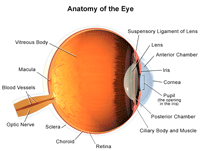Diabetic Retinopathy
Diabetic Retinopathy
Diabetic retinopathy is a diabetes-related eye disease that can lead to vision loss. It causes damage to the blood vessels of the retina, the light-sensitive tissue at the back of your eye. By keeping your diabetes under control and getting regular eye exams, you may help save your sight.
The eyes have it
Retinopathy begins with small areas of swelling in the retina’s blood vessels. As the disease gets worse, some of these blood vessels become blocked. Eventually, so many blood vessels get blocked that several areas of the retina are deprived of the nourishment they need from the blood supply. In response, these areas of the retina signal the body to grow new blood vessels. The next and most advanced stage of the disease is called proliferative retinopathy. At this stage, new blood vessels grow in response to the signals sent by the retina. Unlike the healthy blood vessels, the new ones are abnormal, with thin, fragile walls. If these blood vessels leak blood, the result can be vision loss or even blindness.
Look out for your eyes
Maintaining good diabetes control is important to avoiding retinopathy. Keep your eyes healthy with these tips:
Keep your blood glucose under control, and do not smoke. Research has shown that tight control can slow the onset and progression of retinopathy.
Treat high blood pressure and high cholesterol. Studies show that controlling these factors can help reduce the risk for vision loss.
Have a professional, dilated eye exam at least once a year, even if your vision seems fine.
Detection and symptoms
Even if you take steps to prevent retinopathy, you may still develop the condition. In the early stages, retinopathy often has no symptoms. That’s why it's so important to have a dilated eye exam every year. In this type of exam, special drops are placed in your eyes to widen the pupils. This lets your eye healthcare provider look inside your eyes for signs of disease. As retinopathy progresses, you might notice a few spots floating in your field of vision. These are actually specks of blood. Tell your provider right away if you see spots or have blurry vision. The earlier you get treatment, the more effective it’s likely to be.
Vision-saving treatments
The treatment for retinopathy depends on how the eyes are affected. Some people with retinopathy develop macular edema. This problem happens when fluid leaks into the macula. This is the part of the eye needed for sharp, straight-ahead vision. The fluid causes the macula to swell, causing blurry vision.
Macular edema is treated with focal laser surgery, which helps reduce the risk for vision loss. The surgeon makes numerous tiny laser burns in leaky areas of the retina near the macula. These burns stave off further leaking. This procedure may be needed more than once. Diabetic macular edema can also be treated with injections. These include steroids or other medicines that can slow the growth of new blood vessels.
Proliferative retinopathy is treated with scatter laser surgery. The surgeon makes 1,000 to 2,000 laser burns in areas of the retina farther away from the macula. This procedure may be done during 2 or more sessions. This treatment shrinks abnormal blood vessels. It’s helpful if the vessels haven’t started to bleed yet or are bleeding just a little. With proper treatment, people with proliferative retinopathy have a much smaller chance of developing blindness within 5 years.
In both types of laser treatment, the eye is numbed with special drops before the surgery. The area behind the eye may also be numbed to prevent discomfort. It’s possible that you may feel a stinging sensation during the procedure. Tell your provider if you experience pain in your eye after the procedure.
If you have a lot of blood in the eye, vitrectomy may be needed. This is surgery to remove the vitreous gel in your eye that is clouded with blood. It is replaced with clean, clear fluid.
Talk with your healthcare provider to learn more about preventing diabetic retinopathy. By keeping an eye on your health, you can help preserve your sight.
Updated:
March 21, 2017
Sources:
Standards of Medical Care in Diabetes. American Diabetes Association. Diabetes Care. 2013;36:s11-66..
Reviewed By:
Hurd, Robert, MD,Sather, Rita, RN
